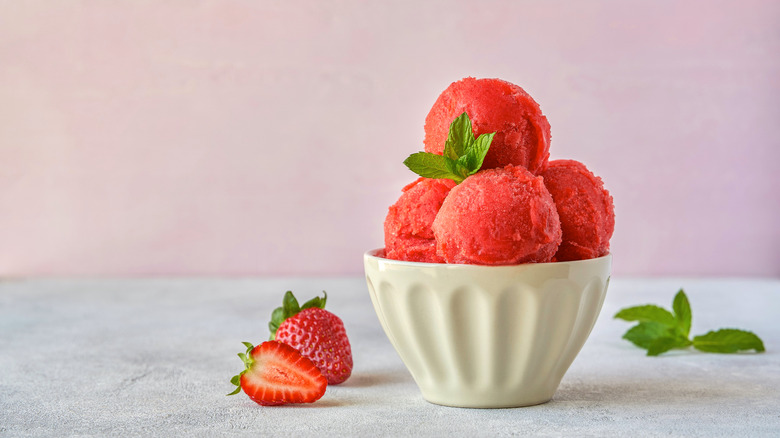The Fancy Way Givré Sorbet Is Served
From ice cream parlor treat to dinner party palate cleanser, it's hard to resist the charms of a good, tangy sorbet. This is an iced delight that slides down easy, doesn't make too many demands, and usually leaves you wanting more. But what is a sorbet? Essentially, it's just frozen fruit puree or juice with sugar syrup or other sweeteners like honey –- but it never includes dairy, as once you add that, you've got a sherbet instead.
Generally, sorbets are made from fruits such as lemon, lime, strawberry, raspberry, mango, or watermelon. And although they work well with tart and citrus flavors, they can also be a good showcase for flowers like jasmine and rose, or herbs and spices like mint, basil, ginger, or even chili. Plus you can experiment with flavors like Earl Grey tea, coffee, or David Lebovitz's "Chocolate Sorbet" recipe from Food 52 (purists, look away now). You can also booze up your sorbet with champagne, wine, rum, gin, or mezcal, or throw in playful ingredients, like chef Bill Smith's "Red Hot Candy Orange Sorbet."
In fact, because sorbets are light, airy, and easy to infuse with flavors, they can be a creative blank canvas for unexpected combos, including Great British Chef William Drabble's "Vodka, Olive Oil and Lemon Verbena" creation. Yet beyond ingredients, you can also experiment with the kind of vessel that you serve this iced delight in. For instance, if you're bored with dessert glasses and cones, why not try making a "givré" sorbet instead?
Here's how to create a more striking sorbet
According to Masterclass, a givré is a sorbet that's served in a fruit rind or husk, such as lemon, orange, grapefruit, pineapple, or coconut. Givré means "frost" in French and traditionally, the shell should be frozen as well to help keep the desert cool. This serving idea is also a nifty way of using up the fruit casings left over from your sorbet, rather than throwing them away. Plus, they can make your desserts more visually interesting and even whimsical (and bonus — they mean fewer dishes too). Givrés are also a way of adding fun and kitschy tropical vibes to refreshments, for instance, serving up a tray of pina colada sorbets stuffed in pineapple rinds at a summer pool party. You can also garnish givrés with a slender curl of the fruit itself, such as this lemon sorbet recipe from Eat Smarter. Or you can scatter delicate flowers over the dish, like Ice Cream Magazine's Gin & Grapefruit givré.
And what about making the sorbet itself? As Masterclass points out, it's all a matter of four simple steps. Start by blending fresh fruit and sugar syrup in a food processor, then strain out any seeds or skin. Next, churn the mixture by hand or machine until it's smooth. Finally, stick it in the freezer for at least four hours. And now that you've got the inside scoop on making sorbets, you can whip up a satisfyingly sour pink grapefruit givré on a hot day. Happy blending.

